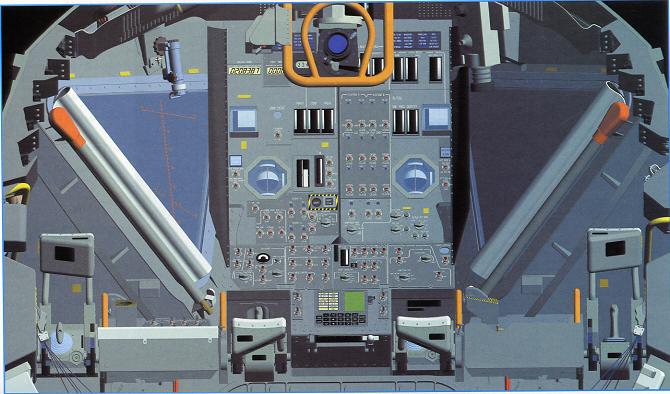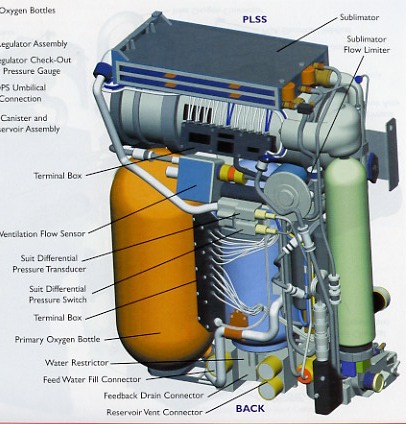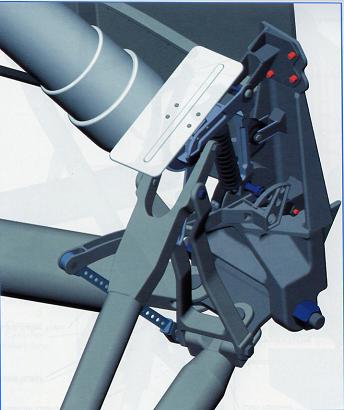S u m m a r y
|
| Title, Description &
Publisher: |
Virtual LM: A Pictorial Essay of the
Engineering And Construction of the Apollo Lunar Module Apogee Books |
| ISBN: |
1-894595-14-0 |
| Media: |
10" x 7" format, 256 semigloss
pages, 3D CAD artwork and color photographs throughout |
| Price: |
$29.99 from
Apogee Books |
| Review Type: |
First Read |
| Advantages: |
Great illustrations, lots of detail,
superdetailing potential, bonus CD-ROM (when it works...) |
| Disadvantages: |
The CD-ROM is terribly buggy, needs
proofreading |
| Recommendation: |
Recommended |
Reviewed by Daryl
Carpenter

HyperScale is proudly supported by
Squadron.com
Back in 2003, Scott P. Sullivan produced Virtual Apollo which detailed
the Apollo Command and Service Modules. While a decent enough book, it
suffered from inaccurate exterior illustrations and some unrefined 3D
models.
Virtual LM covers the Apollo Lunar Module, that spidery spacecraft that
first landed men on the Moon.
The concept is pretty much the same: highly detailed, colorful CAD
models, generated in PTC Pro Engineer, provide an in-depth look at the
interior and exterior of the spacecraft.
Virtual LM is leagues ahead of it's predecessor. It's twice as large as
Virtual Apollo, and contains almost 600 illustrations and computer
models, compared to 200 for Apollo. The close-up views are far superior,
showing small details like wiring, plumbing, structural beams, and so
on. The text is more comprehensive, and the exterior views are far more
accurate, having used David Week's excellent Apollo modeler's plans.
There s simply no way one could absorb all of the material in one
sitting.
The Descent Stage
Chapter one covers the descent stage, which housed the
main propulsion system, the landing gear, and the astronauts' lunar
surface equipment. First up is a series of exterior views of the
spacecraft. The H and J-series LMs are shown from six sides in landing
position. Next are six views of the LM stowed in it's launch vehicle
adapter.
The first chapter covers the spacecraft's descent stage. Described first
are the four "quads" used for storing equipment and supplies. Many
illustrations are provided to show the operation of the scientific bay
doors and MESA deployment assembly. Further models show the MESA itself,
and the cable-and-lanyard ALSEP deployment system.
The Descent Propulsion System, pyrotechnic systems (including cutaways
of the interstage umbilical and interstage connectors), plumbing and
electrical, and the landing radar and covered next.
The largest (17 pages) section covers the landing gear assemblies. Each
major assembly is shown in a number of close-ups and isometric views,
along with cross-sections of the main struts and explanations of the
extension sequence.
The J-series descent stage is described next, showing the differences
with the H-series. The final section shows the assembly of the descent
stage in 25 steps, and also details thermal protection and insulation.
The Ascent Stage
Chapter two covers the Ascent Stage; the astronaut's
living quarters, so to speak. It begins with a series of exterior views,
comparing the H and J-series LMs. It then details the reaction controls
and the numerous antenna studded about the exterior.

Next up is an overview of the overhead docking window,
and the triangular front windows, complete with exploded views showing
each pane and mounting frame. We then move on to the interior pressure
vessel. The egress hatch is shown, as well as overall views of the
flight stations.
Each control panel, as well as the equipment stowage positions and
attitude controllers, are shown in close-up. The docking system (drogue,
docking targets, hatch) is covered next. Also detailed in this chapter
are the Ascent Propulsion System and the environmental controls.
"Ascent Stage From the Ground Up" shows the assembly sequence in 25
steps, from the joining of the cabin segments to the application of
thermal insulation and pyro paint. Next, are ten lightly-annotated
cutaway views of the entire ascent stage. The final section describes
the different types of thermal protection used on both stages.
The Lunar Roving
Vehicle
Chapter Three describes the ubiquitous "moon buggy" used
on Apollos 15 through 17. Once again, there are six exterior views. The
bulk of this chapter actually covers the deployment system and
step-by-step deployment and assembly illustrations.
The electrical system is illustrated, along with the drive and steering
assemblies, and wheels. Further pages detail the center chassis, the
displays and controls, and the equipment pallets.
The Portable Life
Support System
The final chapter the covers the PLSS (the large
backpack worn by moonwalking astronauts).

It starts out with several isometric views, and shows
the interior components of the Oxygen Purge System, the PLSS, and the
Remote Control Unit.
The CD-ROM
As with most Apogee Books titles, Virtual LM comes with
a bonus CD-ROM with additional information.
This is the real hit-and-miss element of the book. While others have had
no problems, it does not want to run smoothly on my system. The disc
isprone to freezing up, crashing, or failing to open images. At one
point the disc became so hot it was almost impossible to hold. Even
after cleaning the CD several times, it still freezes up attempting to
view an image. After much tedium, I finally managed to get it to run.
Here's what's on the CD-ROM:
-
57 hi-res images of the
Ascent Stage of LM Test Article-1 at the Cradle of Aviation Museum
-
49 hi-res images of the
Decent Stage of same craft
-
61 hi-res images of LM
Mission Simulator, also at the Cradle of Aviation There are also a
number of PDF files on the CD-ROM:
-
Apollo 14 LM Activation
Checklist
-
Apollo 14 LM Timeline
Book
-
Apollo 15 LM Cue Cards
-
Apollo 15 LM Data Card
Book
-
Apollo 16 LM Contingency
Checklist
-
Apollo Operations
Handbook: LM-6 And Subsequent:
-
Volume 1 Subsystems Data
Apollo Operations Handbook: LM-5 And Subsequent:
-
Volume 2 Operational
Procedures
Just as with the photographs, opening and viewing the
PDF files is an absolute chore, and not really recommenced unless you
enjoy repetitive whirring and grinding noises.
The nasty bonus CD-ROM aside, Virtual LM is an excellent
visual reference guide to an historic spacecraft. The text could have
used a bit of proof-reading (including one gutbuster involving "fecal
wet wipes"!) I d recommend it to both beginning and hardcore space
enthusiasts (mostly hardcore, if you can get the CD-ROM working!). The
superdetailing and scratchbuilding potential for scale modelers is quite
high, when one considers the myriad close-ups of important components.

I recently received an E-mail from Scott P. Sullivan announcing his
intention to do a sort of "Virtual Classic Sci-Fi Spaceships". Let s
hope he pulls through, and has a word with the Apogee Books quality
control team while he's at it!
Recommended.
Review Copyright © 2005 by
Daryl Carpenter
This Page Created on 28 February, 2005
Last updated 28 February, 2005
Back to HyperScale Main Page
Back to Reviews Page
|
Home | What's
New | Features
| Gallery |
Reviews | Reference
| Forum
| Search